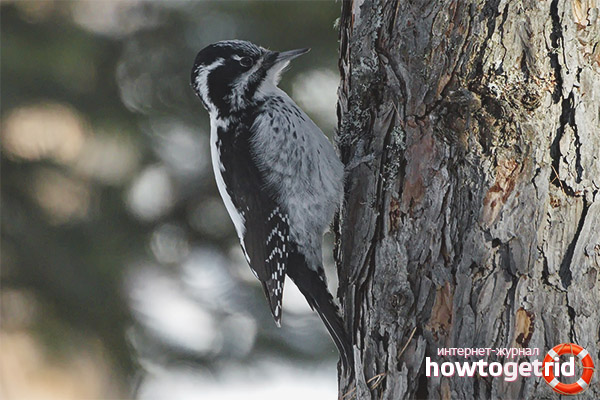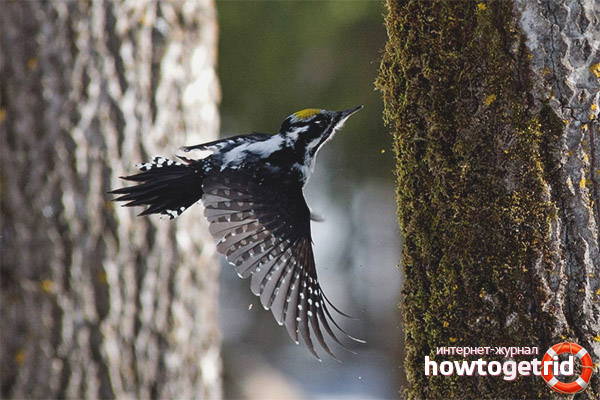The content of the article
The bird belongs to the order woodpeckers, family woodpeckers.
External signs
Three-toed woodpeckers are represented by small birds with a body length not exceeding 25 cm, with a mass ranging from 50 to 90 g. The woodpecker has rather large wings with a span of up to 35 cm. The body ends with a short wedge-shaped tail. The legs of a bird are small in size with three fingers placed on them, two of which have a front direction, and the third looks behind. The body is covered with hard and thick plumage with a complete absence of fluff.
Black colors prevail in the color palette, which are spread almost throughout the body. However, the body is not without white markings. This species is somewhat different from other similar representatives. For example, the head of this representative is not covered with a bright "red cap". On the female’s head, one cannot see a red spot on the back of the head.
The male’s head is characterized by the presence of a “cap” with lemon-yellow color. On the head of the female, a silver-gray color with the presence of dark streaks is noted.
Nature of nutrition
Usually a bird searches for food at an altitude of 1-3 m from the ground. Dead trees are mainly used, although sometimes the female searches for food on the living. In the spring, they drink juice from trees, and berries are present in small amounts in their diet.
Propagation Features
This species belongs to typical monogamous. Puberty occurs when the bird turns one year old. Interesting is the behavior of males during the mating season. They seek out a dry knock and begin to hammer it with their beak. As a result, a characteristic vibrating sound is created. It is he who is attractive to females.
Every year, for the construction of a new hollow, they choose a tree that has died or has become rotten. This can be a representative of conifers, or a deciduous tree, represented by birch, poplar. On average, a little more than a week is spent on the job of forming a hollow. Usually it is located at a height of 1 to 10 m from the surface of the earth. Famous buildings and with a greater height. Both representatives of one pair are engaged in this. The bottom of the hollow is lined with wood dust. She will serve as a laying for eggs, which the female will lay. In total, she will bring them no more than 6 pieces. They are covered with shiny shells. This happens in the middle or in the second half of May. The eggs hatch for two weeks by both parents. They are able to replace each other 6-7 times a day.
Two weeks later, chicks appear from the eggs. Despite the fact that they are naked, blind and seeming completely helpless, they already at this time require a large amount of food. Chicks are very noisy. 4 weeks pass and the chicks begin to emerge from the nest. Moreover, they are already making attempts to fly independently. Having learned to fly a little, they still try to stay close to the "family hearth".They do not strive to fly far from the hollow, because parents still continue to feed them. They will be in the hollow for a whole month.
Habitat characterization
A characteristic feature is that the three-toed woodpecker is referred to the orderlies of the forest. It destroys many harmful insects. For this, he uses only diseased and dead trees. He will never spoil an absolutely healthy tree.
Three-toed woodpeckers belong to silent birds. Compared to other woodpeckers, they have a poorer repertoire. In the mating season, woodpeckers make sounds similar to twittering or chirping. Both floors are hollowed out with a drum roll. By its nature, it resembles an automatic burst.
Video: three-fingered woodpecker (Picoides tridactylus)











Submit